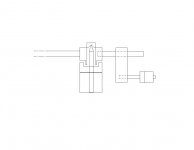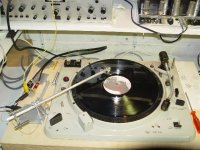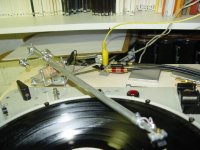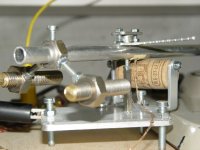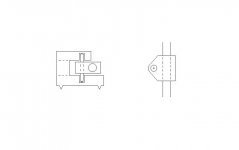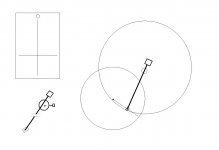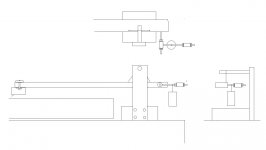For all I know, that may be how everyone is doing it. But as I said, I've never looked at the underside of a unipivot tone arm.
basic principle of unipivot
personally I think full adjustability in all directions is essential
the uni pivot bearing point itself is the easy part
that's the beauty of the principle
note that there is room for thick grease to dampen
thats the Hadcock trick
please note that I have not seen any of the new Hadcock versions
Attachments
the three ball solution...
small bearing assemblies such as these have been used forever (or so it seems) in audio. I have a bunch of old tonearms in pieces that use three or four capative balls in a metal carrier. If the "needle point" is not the correct angle it can bind.
small bearing assemblies such as these have been used forever (or so it seems) in audio. I have a bunch of old tonearms in pieces that use three or four capative balls in a metal carrier. If the "needle point" is not the correct angle it can bind.
As promised, here is my unipivot suggestion ...... I used 1/8" balls because they are easier to find ....The balls could be carbide or some semi-precious stone ....
Ralf
FYI,
I did (in 2005) a minute montage (DIM) with 3+1 balls (cinematic-bearing) ...
Balls are 3mm from the rear-pignon-ricing-bicycle (Eddy Merckx) ...
And it's work,
Karel
Attachments
that last photo tinitus posted.. thats EXACTLY the impression i had that the unipivot bearing had to be, the pin had to be a sharper point than the pocket itself to allow the arm to tilt up and down for moving it into place, and playing warped records
to keep center of balance low, my idea was to cut the weights out of hardwood in oval shapes with the hole off-center towards one end to slide onto the end of the tonearm shaft
is there some kind of formula to determine the arm length and the angle of the head?... id like to model the 3 ball idea, the idea ive been having was to drill an oversized hole... glue into that hole a metal sleeve to protect the really soft wood which at this point is looking like itll be balsa, glue into the end of the unipivot channel a magnet to held hold the bearings in place, put the three bearing balls in there... and then continue with my idea of cutting off the head of a screw and sharpening it to a point to use as a height adjustable pin
for the balsa tonearm right now im thinking of making it rectangular in cross-section, with a strip of carbon fiber glued across the top side for rigidity and strength, while the balsa maintains its ability to absorb the vibrations... if i know what the length of the tonearm beyond the point of pivot had to be overall, how far from the pivot point the head angles, and what that angle is, i could model this entirely and see what i get
to keep center of balance low, my idea was to cut the weights out of hardwood in oval shapes with the hole off-center towards one end to slide onto the end of the tonearm shaft
is there some kind of formula to determine the arm length and the angle of the head?... id like to model the 3 ball idea, the idea ive been having was to drill an oversized hole... glue into that hole a metal sleeve to protect the really soft wood which at this point is looking like itll be balsa, glue into the end of the unipivot channel a magnet to held hold the bearings in place, put the three bearing balls in there... and then continue with my idea of cutting off the head of a screw and sharpening it to a point to use as a height adjustable pin
for the balsa tonearm right now im thinking of making it rectangular in cross-section, with a strip of carbon fiber glued across the top side for rigidity and strength, while the balsa maintains its ability to absorb the vibrations... if i know what the length of the tonearm beyond the point of pivot had to be overall, how far from the pivot point the head angles, and what that angle is, i could model this entirely and see what i get
just so that you know, ball bearings are the worst
bushings are way better
though, ball bearings may be convenient if there is any end play to deal with
but if its possible to use bushings, its way better
its all them moving parts
a uni pivot point 'bearing' is almost like no bearing at all
but both pivot point and cup needs to a very precise match
or else you will get 'play' movement
well, I can just as well show whats spinning around in my head right now


bushings are way better
though, ball bearings may be convenient if there is any end play to deal with
but if its possible to use bushings, its way better
its all them moving parts
a uni pivot point 'bearing' is almost like no bearing at all
but both pivot point and cup needs to a very precise match
or else you will get 'play' movement
well, I can just as well show whats spinning around in my head right now

Attachments
well, that looks like it would work... especially if you used atleast a center punch for the tip of the pin to set in so it doesnt slide around.. i like the idea of using a few balls inside the hole with the screw adjustable pin for height... for the screw with the head cut off and sharpened to a point, id also thread a nut and rubber o-ring on so it can be tightened against the threaded bushing on the table so it doesnt work its way out over time
however, 3 balls, or one of those saffire vee bearings seem like it would work just fine.. i would drill a hole large enough for the balls, or the vee bearing... with the balls i could just drill a hole larger than the pin, glue a magnet into the top of the cup, then drop the 3 balls in and the magnets force should automatically flatten them against the top of the cup and hold them in place...
i dont think i would need to glue a piece of tubing inside to strengthen the wall, but atleast glue a metal bushing over the mouth of the cup so that the pin has something to rest against without damaging the tonearm material itself... i think the entire unipivot contraption could probably be done for $0.50-$1.00 from my local hardware store, with a little extra for the piece of balsa, a strip of carbon fiber to glue to the top of it to maintain rigidity (so the balsa doesnt bend over time) and a cartridge
should i carve the headshell as part of the tonearm, or drill a hole in the end of the tonearm to glue in a threaded bushing so i can attach those removable universal headshells?
however, 3 balls, or one of those saffire vee bearings seem like it would work just fine.. i would drill a hole large enough for the balls, or the vee bearing... with the balls i could just drill a hole larger than the pin, glue a magnet into the top of the cup, then drop the 3 balls in and the magnets force should automatically flatten them against the top of the cup and hold them in place...
i dont think i would need to glue a piece of tubing inside to strengthen the wall, but atleast glue a metal bushing over the mouth of the cup so that the pin has something to rest against without damaging the tonearm material itself... i think the entire unipivot contraption could probably be done for $0.50-$1.00 from my local hardware store, with a little extra for the piece of balsa, a strip of carbon fiber to glue to the top of it to maintain rigidity (so the balsa doesnt bend over time) and a cartridge
should i carve the headshell as part of the tonearm, or drill a hole in the end of the tonearm to glue in a threaded bushing so i can attach those removable universal headshells?
another idea i had for a tonearm was to use a piece of balsa dowel rod... run it through my table saw to cut a groove along one edge for the wiring and then glue it inside a piece of carbon fiber tubing for shape and structural support while maintaining the vibration absorbtion properties of the balsa, has anyone considered something like that?
Hello tinitus
I don't believe that existing unipivot tone arms actually use a pin in a hole with a sharp point.
While it is easy to machine a pin with a sharp point, it is not easy to machine a hole with a sharp point at the bottom. All tools wear the first time they are used. that means, by the time you drill the tenth tone arm, you don't have a sharp point anymore.
I think that manufacturers drill the hole as sharp as they can and then machine a small radius on the mating pin so that the pin will always ride on the tapered part of the hole and never in its point.
I've attached two drawings scale 10:1 and 20:1 to illustrate my point. (no pun intended)
Sincerely,
Ralf
basic principle of unipivot
the uni pivot bearing point itself is the easy part
that's the beauty of the principle
I don't believe that existing unipivot tone arms actually use a pin in a hole with a sharp point.
While it is easy to machine a pin with a sharp point, it is not easy to machine a hole with a sharp point at the bottom. All tools wear the first time they are used. that means, by the time you drill the tenth tone arm, you don't have a sharp point anymore.
I think that manufacturers drill the hole as sharp as they can and then machine a small radius on the mating pin so that the pin will always ride on the tapered part of the hole and never in its point.
I've attached two drawings scale 10:1 and 20:1 to illustrate my point. (no pun intended)
Sincerely,
Ralf
Attachments
those PDFs look a tad backwards, in those you have the hole being perfectly sharp but the pin not being perfectly sharp.. surely its easier to sharpen the pin.. however, with weight riding on it i doubt itll stay sharp for long which leads me to believe 3 bearing balls and a pin would probably be the best idea.. but will the arm move smoothly?
how long does the tonearm need to be, and what angle does the headshell need to be at?.. whats the purpose of the angle and which part of the record am i trying to reach... anyone have a good schematic of a pre-existing tonearm i could use?
how long does the tonearm need to be, and what angle does the headshell need to be at?.. whats the purpose of the angle and which part of the record am i trying to reach... anyone have a good schematic of a pre-existing tonearm i could use?
... which leads me to believe 3 bearing balls and a pin would probably be the best idea.. but will the arm move smoothly?
now that think about it, I think the hadcock actually did use a small ball bearing
btw, maybe you could use a wolfram tig welding electrode for the pin
I would use a sharp punch to make the counterpart cup
if it wears out ? hey, its DIY
i think a bolt would be easiest tinitus.. i mean, i can put a bolt into my drill press chuck and sharpen it with some steel files i have... then thread it into a threaded bushing glued into the table for height adjustment
on the tonearm i think ill just drill out a hole, glue in a small piece of steel tubing to sleeve the hole i drilled, maybe glue a magnet into the pocket, and place the 3 bearing balls in and be done with it forever
ive been thinking of using the balsa wood.. like glueing a balsa dowel into tube steel and how it would work.. but i think i might just go with a tri-lam tonearm being balsa in the middle with a thin slice of oak on the top and bottom of it for structural support
on the tonearm i think ill just drill out a hole, glue in a small piece of steel tubing to sleeve the hole i drilled, maybe glue a magnet into the pocket, and place the 3 bearing balls in and be done with it forever
ive been thinking of using the balsa wood.. like glueing a balsa dowel into tube steel and how it would work.. but i think i might just go with a tri-lam tonearm being balsa in the middle with a thin slice of oak on the top and bottom of it for structural support
First off regarding the uni-pivot. In general the pin would be a socket that received a gem stone ground to an appropriate point. There is also the option of using a material like carbide or tungsten for the point both of which are very hard. The socket will be the ware site. There are a number of ways to fabricate it. The best is again going to be a dimple in a gem that is bonded or captured in a cup. The second would be to again use carbide, tungsten, or another hard metal and EDM it to finish. Most any material that would be suitable to the job and have long term life will be unmachinable due to hardness.
I like the tone arm made up of balsa and some other strength wood like oak or spruce.
The above can be done if you have a machine background and access but... Simple is better.
I like the tone arm made up of balsa and some other strength wood like oak or spruce.
The above can be done if you have a machine background and access but... Simple is better.
for simple i think you cant get any simpler than bearing balls and a sharpened shaft... and i think for the tonearm i will use balsa with a strip of hardwood (probably red oak) glued to the top and bottom... but as i asked before, how long should it be, with what sort of an angle? im not sure how i should shape this thing
my guess is you want it to track perfectly horizontal from the outside of a record to the inside... but since its unipivot, thats not possible, so the longer the arm, the larger the radius, and the closer to straight across it will track would be my guess
but heres what i dont know... why are many heads angled, whats the purpose for that?.. is it to attempt to hold the headshell as parallel to the grooves as possible depending on where the arm is anchored.. and about what length is average, and which length is more ideal for the overall length?
but heres what i dont know... why are many heads angled, whats the purpose for that?.. is it to attempt to hold the headshell as parallel to the grooves as possible depending on where the arm is anchored.. and about what length is average, and which length is more ideal for the overall length?
it looks like this
to find the right adjustment you only need a very simple tool
a piece of paper with a hole fitting over center pin
at any position of needle, the radial line shows you the best compromise
deviation towards inner groove should be slightly less, because of narrower circle
whether you use S-shaped arm, straight, or whatever, principle is the same
best you can do is to make a 1:1 scale drawing of the whole design, tuntable and all
then cut a simple cardboard model
and you can play with paper models of any kind of arme shaper, length, etc
to find the right adjustment you only need a very simple tool
a piece of paper with a hole fitting over center pin
at any position of needle, the radial line shows you the best compromise
deviation towards inner groove should be slightly less, because of narrower circle
whether you use S-shaped arm, straight, or whatever, principle is the same
best you can do is to make a 1:1 scale drawing of the whole design, tuntable and all
then cut a simple cardboard model
and you can play with paper models of any kind of arme shaper, length, etc
Attachments
....... is that what you were saying?
its just to show what happens with a radial arm
drawing is not 100% accurate
but ideally the arm base should be adjustable in all direction
typical arm is 9"
its become industrial standard
maybe because it suits most standard sized turntables
at the other ned, 12" are more or less standard size of long arms
probably because longer ists not practical
and shorter may not give much change/advantage from shorter 9"
it should be obvious why a long radial arm results in less tracking error
but also keep in mind that the needle will have more mass to move
weight also needs to be matched to stiffness/compliance of pickup
high compliance means soft needle 'suspension'
needs a lighter arm
low compliance means stiffer
thus heavier arm is better
it is also related to low frequency ressonance
I think its around 5-10hz, depending on weight
but you can have any arm length in between
as long as it fits on your turntable
its all about adjustments
note, if you like monster subs, be prepared for problems
you will need a sharp sub filter(high pass)
mechanical feedback, acoustic feedback, etc etc
high frequency noise
low end rumble
scratching worn vinyl
hum and buzzing, etc etc
I will say it straight, its fore hardcore enthusiasts
but building arms can be great fun
but I have no vinyl anymore, so....
- Status
- This old topic is closed. If you want to reopen this topic, contact a moderator using the "Report Post" button.
- Home
- Source & Line
- Analogue Source
- diy turntable project... advice needed
